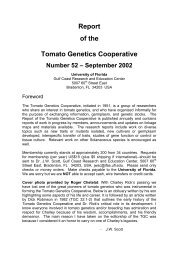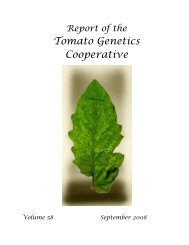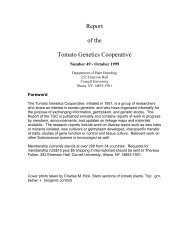Volume 60 - Tomato Genetics Cooperative - University of Florida
Volume 60 - Tomato Genetics Cooperative - University of Florida
Volume 60 - Tomato Genetics Cooperative - University of Florida
Create successful ePaper yourself
Turn your PDF publications into a flip-book with our unique Google optimized e-Paper software.
esistance and very large fruit (Scott et al., 2009). Hypothetically, „Fla. 8109‟ and the<br />
lines developed thereafter contain a resistance gene, missing in „Neptune‟, that was<br />
unlinked from a gene preventing large fruit formation, but this has not been elucidated<br />
yet.<br />
Japan<br />
In Japan, development <strong>of</strong> bacterial wilt resistance in tomato (and eggplant) started<br />
as early as 1951 and was based on the use <strong>of</strong> North Carolina lines. „OTB-1‟ and „OTB-<br />
2‟ are self pollinated <strong>of</strong>fspring obtained in the 1950s respectively from „NC1953-<strong>60</strong>N‟<br />
and „NC1953-64N‟ (Suzuki et al., 1964). According to later reports and papers published<br />
[in Japanese] by the Ministry <strong>of</strong> Agriculture and Forestry (H. Fukuoka 6 , pers. com.)<br />
„OTB-2‟ was segregating for several traits including bacterial wilt resistance (but was<br />
fixed for Fusarium wilt resistance) and was submitted to further screening for bacterial<br />
wilt resistance and further selfing. In 1969 „BF-Okitsu 101‟ was obtained 7 from this<br />
process. „OTB1‟ and „OTB2‟ were described in 1964 by IRAT (French West Indies) as<br />
possessing the traits <strong>of</strong> the Puerto Rican S. pimpinellifolium, but with markedly bigger<br />
fruits and exceptional fruit productivity, together with a good behaviour towards viruses.<br />
Philippines<br />
In Philippines, breeding was established as early as 1954 by T.L. York and J.R.<br />
Deanon who evaluated local and foreign accessions with known resistance to bacterial<br />
wilt (Deanon, 1988). The exact origin <strong>of</strong> the resistance source(s) used in the Philippines<br />
breeding scheme is not found in the literature and hence remains confusing (Deanon,<br />
1988; Wang et al., 1998). Empig et al. (1962) report some resistance in Philippine<br />
native material, such as „Los Baños native‟ which has possibly been used in the local<br />
breeding research. J. Acosta 8 conducted research on the inheritance <strong>of</strong> tomato bacterial<br />
wilt resistance at the <strong>University</strong> <strong>of</strong> Hawaii (Acosta et al., 1964) and one can hypothesize<br />
(i) that he took Philippine material to Hawaii 9 and conversely (ii) that he brought material<br />
back home (to the Philippines). North Carolina material entered Philippines breeding<br />
program according to Mew & Ho (1977). These authors, on the basis <strong>of</strong> a personal<br />
communication <strong>of</strong> J.R. Deanon, indicate that „Venus‟ (North Carolina line) entered the<br />
pedigree <strong>of</strong> the Philippine line „UPCA1169‟, together with a „CA64-1169‟ <strong>of</strong> unmentioned<br />
origin (Figure 1). „UPCA1169‟ is itself at the origin <strong>of</strong> other Philippines<br />
material such as „VC8-1-2‟ and „VC9-1‟ (Mew & Ho, 1977; Wang et al., 1998; Scott et<br />
al., 2005). The origin(s) <strong>of</strong> the resistance <strong>of</strong> other valuable Philippine material, such as<br />
„TML46‟, „TML114‟, „R3034‟, or „HSBW‟ mentioned in the Hawaii section is not known.<br />
6<br />
Dr H. Fukuoka, National Institute <strong>of</strong> Vegetable and Tea Science, Kusawa 3<strong>60</strong>, Ano, Tsu, Mie 514-2392,<br />
Japan.<br />
7<br />
„BF-Okitsu 101‟ was obtained by A. Kotani, T. Kuriyama, H. Shimada-Mochizuki, S. Sakuma, and I.<br />
Suzuki (H. Fukuoka, pers. com.).<br />
8<br />
According to http://www.t<strong>of</strong>il.ph/awardee_pr<strong>of</strong>ile.php?id=78, J Acosta won a Rockefeller scholarship to<br />
the <strong>University</strong> <strong>of</strong> Hawaii in 1958. This is also indicated in Acosta (1963).<br />
9<br />
This hypothesis is consistent with the information <strong>of</strong> Gilbert to Laterrot (Laterrot et al., 1978) that a<br />
Philippine source had been used in Hawaii and is at the origin <strong>of</strong> „Hawaii 7996‟.<br />
11





